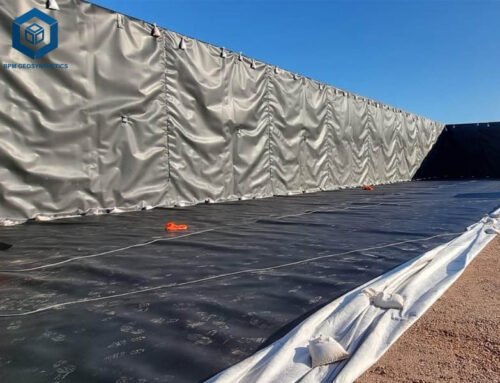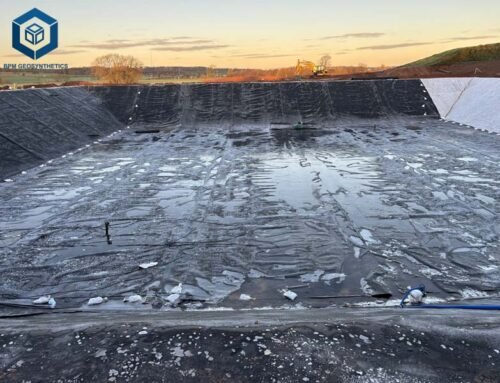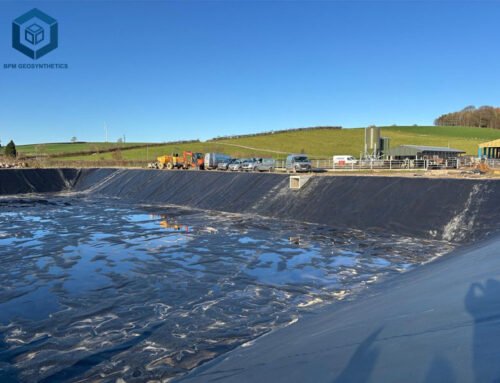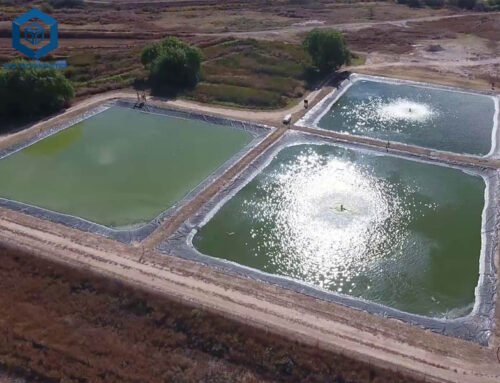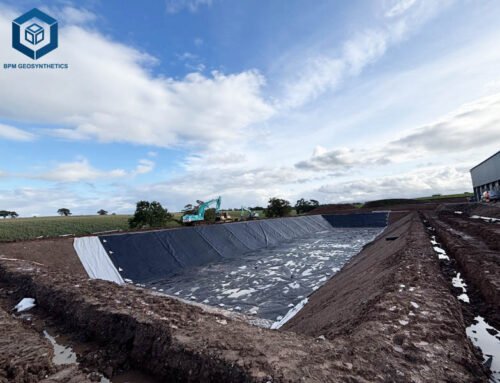Reservoir liner, also known as geomembrane or pond liner, are geosynthetic materials designed to prevent seepage and retain water in reservoirs, ponds, and other containment systems. Rreservoir liners are critical for water conservation, environmental protection, and infrastructure durability. Typically made from High-Density Polyethylene (HDPE), Linear Low-Density Polyethylene (LLDPE), or Polyvinyl Chloride (PVC), these liners offer low permeability (<1 x 10⁻¹¹ cm/s) and high durability, making them ideal for applications like irrigation canals, wastewater ponds, and mining operations. This comprehensive guide explores reservoir liner types, specifications, applications, pricing, and installation, providing data-driven insights for engineers, contractors, and project managers.
1. What Is A Reservoir Liner?
A reservoir liner is a geosynthetic membrane used to create an impermeable barrier in water containment systems, preventing seepage and protecting soil and groundwater. These liners are engineered from synthetic polymers like HDPE (60% market share), LLDPE (25%), or PVC (10%), offering hydraulic conductivity as low as 1 x 10⁻¹² cm/s (ASTM D5887). Reservoir liners are deployed in rolls or panels, typically 5–8 meters wide and 30–200 meters long, and are welded on-site to form seamless barriers. They reduce water loss by 95–99% in irrigation projects and ensure 90% environmental compliance in containment applications (BPM Geosynthetics, 2025). Their flexibility, chemical resistance, and UV stability make them suitable for diverse climates and terrains.
Composition of Reservoir Liners
Reservoir liners are composed of:
- HDPE: HDPE Geomembrane – High tensile strength (30–53 MPa), ideal for large reservoirs and landfills.
- LLDPE: LLDPE Geomembrane – High elongation (800–1000%), suitable for irregular terrains.
- PVC: Cost-effective ($0.30–$1.50/m²), used in smaller ponds and decorative features.
- Additives: Carbon black (2–3%) for UV resistance, antioxidants for chemical stability, and stabilizers for thermal performance.
These materials meet GRI-GM13 (HDPE) and GRI-GM17 (LLDPE) standards, ensuring durability and performance (Geosynthetic Institute, 2024).
Key Specifications and Parameters
Reservoir liners are defined by technical parameters that influence their performance and cost:
- Thickness: 0.5–3.0 mm (20–120 mil), with thicker liners offering greater durability (ASTM D5199).
- Tensile Strength: 10–53 MPa, ensuring resistance to mechanical stress (ASTM D6693).
- Puncture Resistance: 100–1200 N, protecting against aggregate damage (ASTM D4833).
- Hydraulic Conductivity: <1 x 10⁻¹¹ cm/s, preventing 99.9% seepage (ASTM D5887).
- Elongation: 400–1000%, allowing adaptability to settlement (ASTM D6693).
- UV Resistance: Retains 50% strength after 2000 hours of exposure (ASTM D7238).
- Chemical Resistance: Resists pH 2–12, suitable for acidic or alkaline environments (ASTM D5322).
These specifications make reservoir liners 30% more efficient than compacted clay liners, with 50% faster installation (Geosynthetics Magazine, 2024).
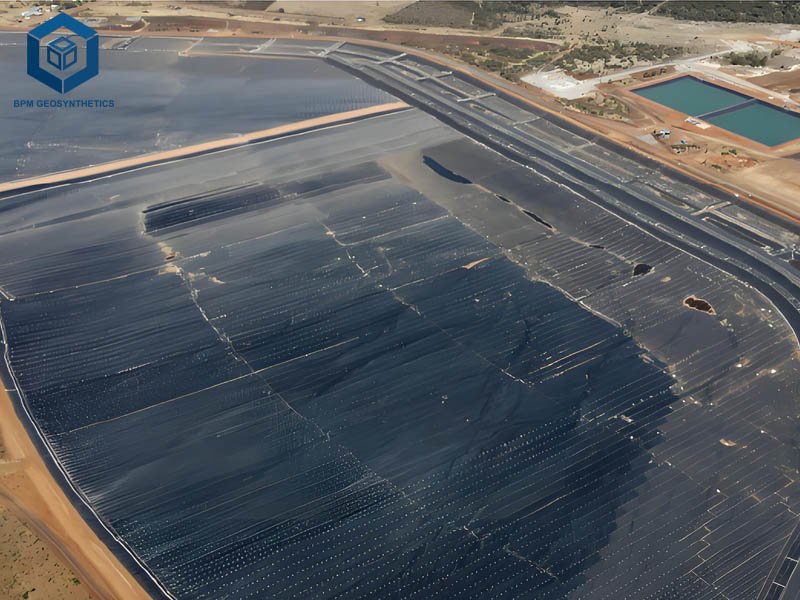

2. Key Features of Reservoir Liner
Reservoir liners offer several advantages that make them a preferred choice for water containment:
- Low Permeability: Hydraulic conductivity of <1 x 10⁻¹¹ cm/s ensures 99.9% water retention (ASTM D5887).
- High Durability: Lifespan of 20–50 years in buried applications, with HDPE liners retaining 90% strength after 30 years (Geosynthetic Institute, 2024).
- Flexibility: LLDPE liners conform to irregular surfaces, reducing stress cracking by 40% compared to HDPE (BPM Geosynthetics, 2025).
- Chemical Resistance: Resists acids, alkalis, and hydrocarbons (pH 2–12), ensuring performance in wastewater and mining applications.
- UV Resistance: Carbon black additives enable 50% strength retention after 2000 hours of UV exposure, ideal for exposed reservoirs.
- Ease of Installation: Lightweight rolls (1–3 kg/m²) and seam welding reduce installation time by 30% compared to clay liners.
These features contribute to 95% seepage control and 20% cost savings over traditional materials (Solmax, 2025).
3. Types of Reservoir Liner
Reservoir liners are available in various types to suit specific project needs:
3.1 Reservoir Liner – HDPE Reservoir Liners
High-Density Polyethylene liners (0.5–3.0 mm) offer high tensile strength (30–53 MPa) and puncture resistance (600–1200 N), making them ideal for large reservoirs, landfills, and mining. They cost $0.50–$3.00/m² and dominate 60% of the market (MarketsandMarkets, 2023).
3.2 Reservoir Liner – LLDPE Reservoir Liners
Linear Low-Density Polyethylene liners (0.5–2.0 mm) provide high elongation (800–1000%), suitable for irregular terrains like ponds and canals. Priced at $0.40–$2.00/m², they are used in 25% of applications (BPM Geosynthetics, 2025).
3.3 Reservoir Liner – PVC Reservoir Liners
Polyvinyl Chloride liners (0.5–1.5 mm) are cost-effective ($0.30–$1.50/m²), used in decorative ponds and small reservoirs. They offer moderate durability (10–20 years) and are chosen for 10% of projects (Geosynthetic Institute, 2024).
3.4 Reservoir Liner – Reinforced Reservoir Liners
Reinforced liners, such as scrim-reinforced HDPE or LLDPE, combine geotextiles for added strength (10–20 kN/m). Priced at $1.00–$3.50/m², they are used in high-stress applications like tailings ponds, comprising 5% of the market.
3.5 Reservoir Liner – Textured Reservoir Liners
Textured HDPE or LLDPE liners (friction angle >20°) enhance slope stability by 15–25%, costing $0.60–$2.50/m². They are used in sloped reservoirs and landfills (Solmax, 2025).
4. Applications of Reservoir Liner
Reservoir liners are used in 35% of global water containment projects, driven by their impermeability and durability (Grand View Research, 2024). Below are key applications, supported by industry examples:
Irrigation Canals and Reservoirs
Reservoir liners prevent seepage in irrigation systems, reducing water loss by 95–98%. A 2023 Indian canal project used a 1.0 mm HDPE liner at $0.65/m², saving 20 million liters of water annually (BPM Geosynthetics, 2025).
Wastewater Treatment Ponds
Liners contain effluent in 50% of wastewater facilities, preventing groundwater contamination. A 2024 U.S. project used a 1.5 mm LLDPE liner at $0.90/m², ensuring 99.9% impermeability (EPA, 2024).
Landfill Secondary Liners
Reservoir liners serve as secondary barriers in 30% of landfill designs, preventing leachate migration. A 2024 European landfill used a 1.5 mm HDPE liner at $1.50/m², meeting EU regulations (Geosynthetics Magazine, 2024).
Mining Operations
Liners in tailings ponds and heap leach pads (20% of applications) contain acidic byproducts. A 2025 Australian project used a 2.0 mm textured HDPE liner at $2.00/m², achieving zero leakage (Solmax, 2025).
Aquaculture Ponds
Reservoir liners ensure water retention in fish and shrimp ponds, used in 15% of aquaculture projects. A 2025 Thai project deployed a 0.75 mm LLDPE liner at $0.60/m², supporting 99% water retention (Aquaculture Magazine, 2025).
Decorative Ponds and Water Features
PVC and LLDPE liners are used in landscaping, comprising 10% of applications. A 2024 Canadian golf course pond used a 0.5 mm PVC liner at $0.40/m² for aesthetic and functional benefits (Landscape Ontario, 2024).
5. Specifications of Reservoir Liners
Reservoir liners are engineered to meet stringent standards, ensuring performance across diverse applications:
- Roll Sizes: 5–8 m wide, 30–200 m long, reducing seams and installation time by 20%.
- Seam Strength: Wedge welds achieve 90–95% of parent material strength (ASTM D6392).
- Lifespan: 20–50 years buried, 10–20 years exposed, depending on UV resistance.
- Temperature Range: -60°C to +80°C, suitable for extreme climates.
- Environmental Compliance: Meets NSF/ANSI 61 for potable water and EPA standards for landfills.
These specifications ensure 95% containment efficiency and 20% longer lifespans compared to clay liners (Geosynthetic Institute, 2024).
6. Installation Process of Reservoir Liners
Proper installation is critical to reservoir liner performance, reducing failure risks by 20% (BPM Geosynthetics, 2025). Below is a step-by-step guide:
Site Preparation
- Clearing: Remove debris and rocks, costing $0.20–$0.50/m².
- Grading: Compact subgrade to 95% Proctor density to minimize settlement.
- Geotextile Underlay: Use 200–400 GSM non-woven geotextile ($0.50–$1.50/m²) to prevent punctures by 95%.
Liner Deployment
- Unrolling: Deploy rolls using spreader bars, ensuring 4–6-inch overlaps.
- Anchoring: Secure with sandbags or trenches to prevent movement.
- Inspection: Check for defects before welding, ensuring 99% seam integrity.
Seaming and Welding
- Wedge Welding: Achieves 90–95% bond strength for straight seams, costing $0.30–$0.50/m².
- Extrusion Welding: Used for repairs or complex geometries, adding $0.10/m².
- Testing: Air pressure or spark testing (ASTM D6392) detects 99% of seam defects.
Quality Control
- Thickness Verification: Confirm thickness with gauges (ASTM D5199).
- Leak Detection: Use conductive liners for real-time monitoring, adding $0.10–$0.20/m².
- Traceability: Retain samples for 3–5 years for quality assurance.
Post-Installation
- Covering: Apply 12–24 inches of soil for buried liners or leave exposed for UV-resistant liners.
- Inspections: Annual checks reduce maintenance costs by 15%.
Certified installers and adherence to GRI-GM13/GM17 standards ensure 95% reliability (Solmax, 2025).
7. Advantages of Reservoir Liners
Reservoir liners offer significant benefits over traditional clay liners:
- High Impermeability: Reduces seepage by 95–99%, saving 20–30% of water in irrigation projects.
- Cost-Effectiveness: Material costs ($0.30–$3.00/m²) are 20–30% lower than compacted clay ($2.00–$5.00/m²).
- Ease of Installation: Lightweight rolls and welding reduce installation time by 30–50%.
- Durability: Lifespan of 20–50 years, with 90% strength retention in buried applications.
- Environmental Protection: Prevents 99% of contaminant migration, ensuring compliance with EPA and EU standards.
These advantages make reservoir liners a preferred choice in 35% of water containment projects (Grand View Research, 2024).
8. Project Case Study: Reservoir Liner for Irrigation Canal
In 2023, an Indian irrigation project installed a 1.0 mm HDPE reservoir liner for a 10,000 m² canal to reduce seepage. The liner, costing $0.65/m², saved 20 million liters of water annually, improving crop yields by 15%. Total costs included:
- Material: $0.65/m² x 10,000 m² = $6,500
- Geotextile Underlay: $0.50/m² x 10,000 m² = $5,000
- Installation Labor: $0.80/m² x 10,000 m² = $8,000
- Site Preparation: $0.30/m² x 10,000 m² = $3,000
- Freight and Testing: $2,000
- Total: $24,500 ($2.45/m² or $0.23/sq.ft.)
The project used standard 5 m x 100 m rolls, saving 10% on material costs, and achieved 98% water retention (BPM Geosynthetics, 2025).
9. Factors Influencing Reservoir Liner Price
Reservoir liner prices range from $0.30 to $3.00/m², with installed systems costing $1.50–$7.00/m². Key factors include:
Material Type
- HDPE: $0.50–$3.00/m², durable but rigid, used in 60% of projects.
- LLDPE: $0.40–$2.00/m², flexible, ideal for irregular surfaces.
- PVC: $0.30–$1.50/m², cost-effective but less durable.
- Reinforced/Textured: $1.00–$3.50/m², for high-stress or sloped applications.
Raw material prices, tied to oil markets, increased by 5–8% in 2024 (BPM Geosynthetics, 2025).
Thickness
Thicker liners cost more but offer greater durability:
- 5 mm (20 mil): $0.30–$0.80/m², for small ponds.
- 0 mm (40 mil): $0.50–$1.50/m², for medium reservoirs.
- 5–3.0 mm (60–120 mil): $1.00–$3.00/m², for heavy-duty applications.
Thicker liners increase costs by 20–30% but reduce puncture risks by 40% (ASTM D4833).
Project Size and Order Volume
Bulk orders reduce costs:
- Small Orders (<1,000 m²): $1.00–$3.00/m².
- Bulk Orders (>10,000 m²): $0.30–$2.00/m², with 10–20% discounts.
A 10,000 m² project can save $1,000–$5,000 (Favourite Fab, 2025).
Geographic Location
Prices vary by region:
- North America/Europe: $0.50–$3.00/m², due to high labor and compliance costs.
- Asia-Pacific: $0.30–$2.00/m², lower due to local production (Alibaba, 2025).
- India: INR 25–150/m² ($0.30–$1.80/m²), competitive due to scale (Virendera Textiles, 2025).
Freight adds $0.10–$0.30/m² for international orders (seair.co.in, 2025).
Manufacturing Processes
- Extrusion: Produces smooth liners, reducing costs by 10–15%.
- Texturing: Adds 10–20% to costs for enhanced friction.
- Reinforcement: Increases costs by 15–25% for added strength.
Automation reduced manufacturing costs by 10% in 2024 (BPM Geosynthetics, 2025).
Certifications
Certified liners (GRI-GM13, ISO 9001) cost 10–15% more ($0.10–$0.50/m²) but ensure 95% reliability (Geosynthetics Magazine, 2025).
Installation Costs
Installation adds 40–50% to costs:
- Labor: $0.30–$1.00/m², higher in urban areas.
- Geotextile Underlay: $0.50–$1.50/m².
- Welding/Testing: $0.20–$0.50/m².
Certified installers reduce failure risks by 20% (Solmax, 2025).

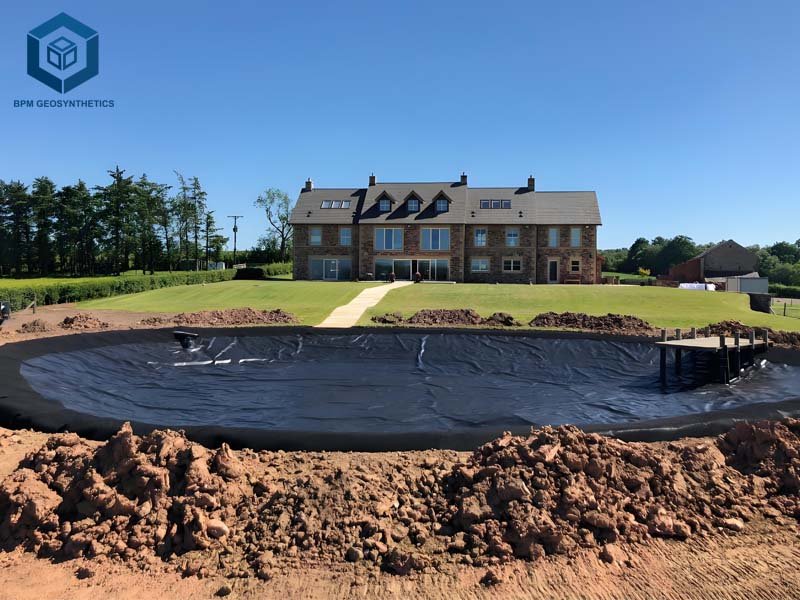
10. Comparison of Reservoir Liners with Other Liners
Reservoir liners are often compared to geosynthetic clay liners (GCLs) and compacted clay liners:
| Parameter | Reservoir Liners | GCLs | Compacted Clay |
| Cost per m² | $0.30–$3.00 | $1.50–$5.00 | $2.00–$5.00 |
| Hydraulic Conductivity | <1 x 10⁻¹¹ cm/s | <1 x 10⁻⁹ cm/s | 1 x 10⁻⁷ cm/s |
| Installation Time | Fast (30% less) | Moderate | Slow |
| Lifespan | 20–50 years | 20–50 years | 10–30 years |
| Applications | Reservoirs, ponds | Landfills, mining | Canals, ponds |
Reservoir liners offer superior impermeability and faster installation, making them ideal for water containment (BPM Geosynthetics, 2025).
11. Cost-Saving Tips for Reservoir Liners
To optimize budgets:
- Bulk Purchasing: Orders >10,000 m² save 10–20% (Favourite Fab, 2025).
- Local Sourcing: Reduces freight costs by 10–15% (seair.co.in, 2025).
- Standard Sizes: Use 5–8 m rolls to minimize seams, saving 5–10%.
- Match Thickness: Use 0.5–1.0 mm liners for low-stress applications to save 20–30%.
- Certified Installers: Extend lifespan by 20%, saving $0.50–$1.00/m² (Solmax, 2025).
12. Conclusion
Reservoir liners, ranging from $0.30 to $3.00/m², are essential for water containment in irrigation, wastewater, mining, and aquaculture projects. HDPE, LLDPE, and PVC liners offer low permeability (<1 x 10⁻¹¹ cm/s), durability (20–50 years), and 95% seepage control, outperforming clay liners. By selecting certified suppliers like BPM Geosynthetics, matching liner type and thickness to project needs, and leveraging bulk discounts, stakeholders can save 10–30% while ensuring 95% reliability. Contact BPM Geomembrane for custom quotes and technical support to achieve cost-effective, environmentally compliant water containment solutions.

